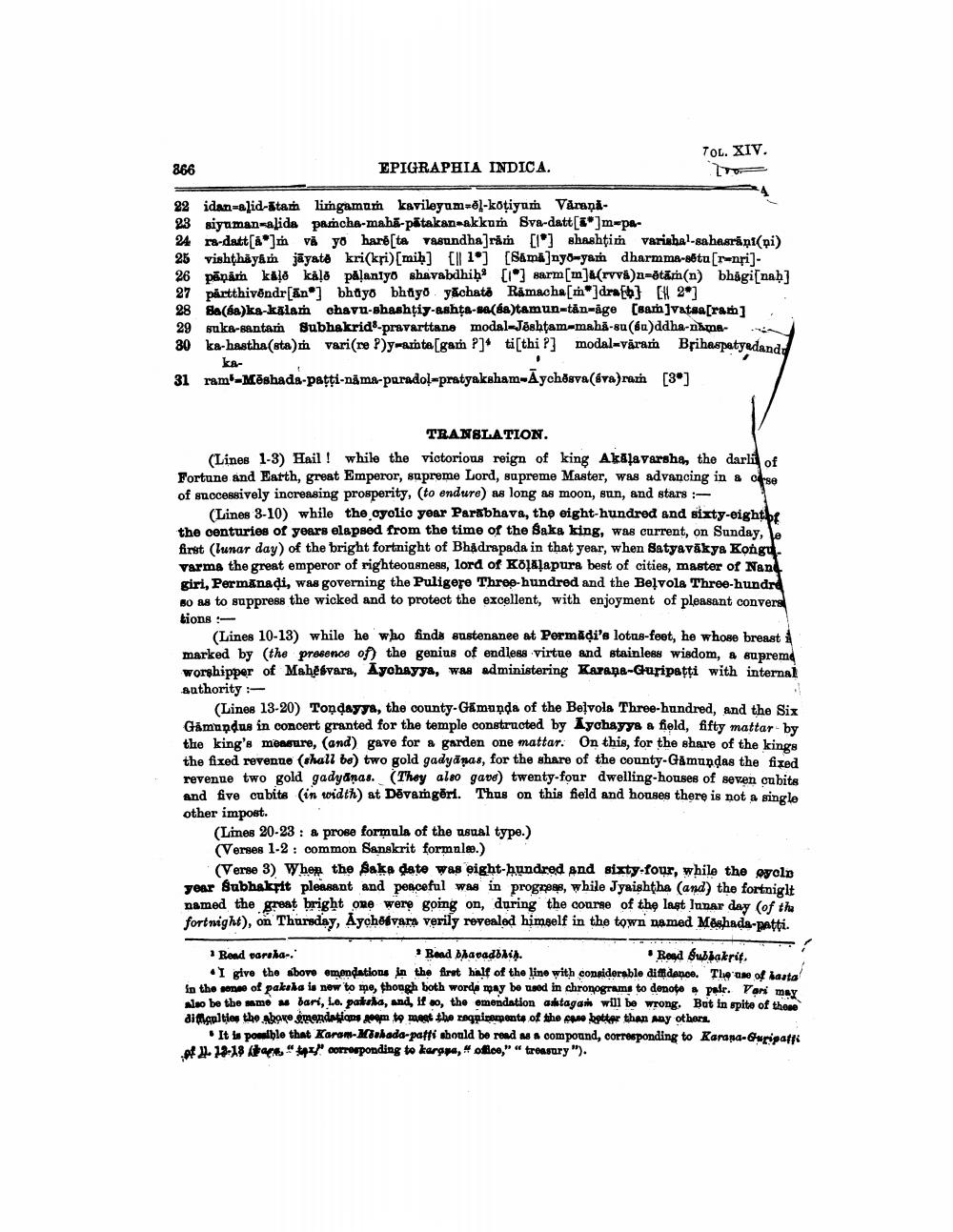________________
TOL. XIV.
866
EPIGRAPHIA INDICA.
22 idan-alid-Stam lingamum kaviloyum=él-koțiyum Varana23 siyuman-alida pamcha-maha-patakan-akkum Bva-datt[]m-pe24 ra-datt[a] Viyo harésta vasundha]rå [] shashtim variabal-sahasrani(pi) 25 vishthayam jāyatė krikri)[mih] [11] [Samk]nyo-yam dharmma-sbtu[rænri] 26 pāņām kald kald pålaniyo shavabdhiḥ [1] sarm[m]4(rvvá)n=ētām(n) bhägi[nab] 27 pártthivēndr[Ano] bhayo bhayo yachat: Ramache[mo]dra [b] [1 2 28 Sa(sa)ka-kalam chavu-shashtiy-eshţa-sa(sa)tamun-tån-age (samvatsa[ram] 29 suka-santam Subhakrid-pravarttane modal-Jöshtam-mahi-su(u)ddha-name80 ka-hastha (sta)th vari(re P)y-arta[gam P]* tisthi P] modal-varazh Brihaspatyadando
ka31 ram'-Mēshada-paçţi-näma-paradol-pratyaksham-Āychova(Ava)rar [3]
TRANSLATION. (Lines 1-3) Hail! while the victorious reign of king Akalavarshe, the darlit of Fortune and Earth, great Emperor, supreme Lord, sapreme Master, was advancing in a case of successively increasing prosperity, (to endure) as long as moon, sun, and stars :
(Lines 3-10) while the oyolio year Parabhava, the eight-hundred and sixty-eightbe the centuries of yours elapsed from the time of the Saks king, was current, on Sunday, le first (lunar day) of the bright fortnight of Bhădrapada in that year, when Satyavākya Kongo Varms the great emperor of righteousness, lord of Koja?apura best of cities, master of Nand giri, Permanadi, was governing the Puligere Three-hundred and the Beļvola Three-hundrd BO as to suppress the wicked and to protect the excellent, with enjoyment of pleasant convers tions -
(Lines 10-13) while he who finds sustenanee at PermAdi's lotas-feet, he whose breast i marked by the presence of the genius of endless virtue and stainless wisdom, a suprema worshipper of Mahesvara, Ayobayya, was administering Karana-Ghuripatti with internal authority -
(Lines 13-20) Tondayya, the county-Gamanda of the Belvols Three-hundred, and the Six Gåmandas in concert granted for the temple constructed by Iychayye a field, fifty mattar by the king's monsure, (and) gave for a garden one mattar. On this, for the share of the kings the fixed revenue (shall be) two gold gadyāpas, for the share of the county-Gåmundas the fixed revenne two gold gadyanas. (They also gave) twenty-four dwelling-houses of seven cubits and five cubite in width) at Dēvamgēri. Thus on this field and houses there is not a single other impost.
(Lines 20-23 : a prose formula of the usual type.) (Verses 1-2 : common Sanskrit formule.)
(Verse 3) When the Baka date was eight-hundred and sixty-four, while the myolu year Subhakrit pleasant and peaceful was in progress, while Jyaishtha (and) the fortniglt named the great bright one were going on, during the course of the last lunar day (of the fortnight), on Thursday, Aycho vara verily revealed himself in the town named Meshada-patti.
Read carshaBead bhacadikin.
Red Subbakrit, I give the sbove emendations in the first half of the line with considerable diffidence. The use of hasta in the one of paksha is new to me, though both words may be tood in chronograms to denoto a pale. Vari may
leo be the mme M bari, le patata, And, if so, the emendation autagai will be wrong. But in spite of those dificaties the above emendations to meet the reqpiraupent of the new batter than Aay other
It is poolble that Karam-Mohada-patti should be read as a compound, corresponding to Karana-Guripark 12-18 px" corresponding to karapa, office," "treasury").




